Church of MO: Twin Touring Sportbikes
One score and four years ago, when MO was in the process of being potty-trained and the world still had hair, it was normal to post a two-bike comparison that wound up comparing three bikes by the time it was over. In those days, no touring Twin needed more than two valves per cylinder, nor water to cool itself. And it was good.
Twin Touring Sportbikes
Buell’s S3T Thunderbolt v. Ducati’s ST2 Sport Turismo
From these three main categories come hybrids, and this is where marketing departments have taken a few liberties. Dual-sport motorcycles, for example, are not sportbikes but standards that can be ridden, for the most part, on dirt and gravel roads. Then there are sport-touring motorcycles, a category created for the middle-aged rider who prefers a more aggressive bike than a cruiser or full dresser, yet is either intimidated by hardcore sportbikes like GSX-Rs and 916s, or after riding one for a few miles, finds it necessary to make an appointment with a chiropractor. An easy way to tell if a manufacturer intends a bike to fall within the sport-tourer category is to look for an “S” or a “T” somewhere in the bike’s nomenclature.
But being geeks conditioned to a world of precise commands and codes, the staff at MO tends to have very literal minds. To us, words have specific, precise meanings, so when we hear “sport-touring motorcycle,”
specific bikes come to mind: Honda’s ST1100 and BMW’s R1100RS, for example. Quick, comfortable, touring bikes that handle relatively well — touring motorcycles with sporty capabilities.
When we were dreaming up shootouts, we wanted to take some long rides, so we immediately penciled into our editorial schedule, “Sport-Tourer Shootout.” Searching for any excuse to flee Los Angeles, we scheduled a couple of runs up north, and with the introduction of Buell’s S3T Thunderbolt and Ducati’s ST2 Sport Turismo, there were now enough “S” or “T” bikes on the market for perhaps two or three northerly excursions. First, we would compare the twin-cylinder sport-tourers, the Buell and Duc along with BMW’s R1100RS. Later, we’ll test the multi-cylinder bikes.
After a few miles on the tight mountain roads between Gorman and Paso Robles, we noticed that the Ducati and the Buell felt at home while the R1100RS, so comfortable on the freeways and highways, had a very hard time keeping up. Sitting in a Paso Robles motel room drinking Coronas and mutilating limes with a butter knife we’d lifted from the Denny’s across the street, it dawned on us, between burps, that we might have stumbled upon yet another hybrid class of motorcycle.
The ST2 and the S3T are not so much sport-tourers, as touring sports. What’s the difference, you say? Well, in “sport-tourers”, “sport” modifies “tourer.” Thus, a “sport-tourer” is essentially an aggressive touring bike, like the BMW R1100RS. However, flip-flop the words, where “touring” modifies “sport”, you have a completely different concept — a sportbike with touring features. It seems as though we are splitting semantic hairs, but we feel the difference looms large. This is how we see the Ducati ST2 and the Buell S3T Thunderbolt — sportbikes set up for touring duty.
Touring, especially overnight runs through your favorite backroads, is something both these bikes do well. The stock seats on both aren’t bad, they’re just not great. Seating positions and overall rider ergonomics are good. Where one bike is comfortable, the other isn’t and vica-versa. The Ducati is more hardcore sport. Lower bars place the rider farther over the front wheel than on the Buell, and the pegs are swept a little farther back. The Duc’s fairing managed windblast well at high speeds and helped keep weight off the rider’s wrists, but at speeds below 70 mph the ST2’s more aggressive, forward riding position was uncomfortable for long-distance freeway riding. The Buell’s more upright position felt great in the city and at low and medium speeds. Conversely, it was at high speeds, over 85 mph, that windblast became bothersome.
The straight, wide-open road will not make these bikes happy. Like their sportbike cousins, the ST2 and the S3T are at home on tight, twisting roads. In the slower, tighter corners, the Buell has the decided advantage with its smaller wheelbase and wide handlebars that offer greater leverage. In the fast corners both bikes handled very well. However, we were surprised that the ST2 is a relatively “heavy” turning bike. “Light” and “quick turning” are descriptives generally associated with Ducs, yet the Buell turned quicker. In designing the ST2, Ducati opted for more stability.
The ST2’s chassis sports a tubular trestle frame similar to the 916 in torsional rigidity and lightness. Weight distribution of the Ducati is spread out between the front and rear a little more evenly than the Buell, which exhibits a rear-weight bias. Accordingly, the Buell doesn’t always want to keep its front end on the ground, and it can be slightly twitchy in high speed corner transitions. However, its excellent chassis and stiff suspension helped keep the S3T very stable over fast, rough roads.
Overall, the braking on the Buell was better than on the Ducati. The Nissin six-piston caliper and sintered metal pad bind with amazing force. In fact, the initial bite is so strong that you can’t simply “grab a handful,” despite having only a single front rotor. The Ducati is equipped with twin 320 mm floating Brembo discs and four-piston calipers in the front and a single 245 mm disc with a twin-piston caliper at the rear. Initial bite was a bit soft, thus a bit more forgiving. Still, perhaps because of the forward position of the rider, the Ducati suffered from greater brake dive than the Buell.One area in which the Ducati clearly had the advantage over the Buell is ground clearance. The Ducati’s narrow footpegs are set higher and farther back than the Buell’s lower and more comfortable pegs. Also,
with the saddlebags off, the Ducati’s muffler can be raised for even more ground clearance. A very trick feature.
The Buell S3T (and the S3 as well) is powered by the same engine we raved about in our review of the S1 White Lightning, pumping out 88 horsepower at the rear wheel and 76 ft-lbs of torque. Suprisingly, all that power came at a relatively low cost. The S3T averaged 43 miles per gallon. The Ducati is powered by a new version of its 90-degree, liquid-cooled V-twin engine, enlarged to 944cc for touring duty. SOHC, 2-valve desmo heads similar to Ducati’s early Paso models, are employed. The ST2 averaged 39 miles per gallon. The ThunderStorm is clearly the more powerful engine, and the only complaint we have stems from the familiar heat from the right side pipes and the trademark vibration at idle that all but disappears when the engine revs over 3000 rpm. The Ducati was clearly smoother at idle and low speeds, but we did note some mirror distortion at a higher clip on the freeway. Clutch and shifting play were very similar, both having a heavy feel and pull.
In the end, both the Ducati and the Buell were in a virtual tie. However, what tipped the balance in favor of the Ducati was the ST2’s overall fit and finish. We liked the easy-to-read instrument panel, and the digital odometer and water temperature gauge. Buell’s minimalist instrument panel, which works well with the naked Cyclone and Lightning, is lacking on a touring sport. Ducati has excellent, easy-to-open-and-remove hardbags, similar to the BMW’s popular and functional system. On the other hand, the Buell’s bags aren’t designed to be removed unless they are open and empty (though, to Buell’s credit, the bags do come with a nice set of removable bag liners). In fact, we couldn’t open the right side bag at all due to an early production glitch that Buell has since corrected.
The Ducati ST2’s sleek and stylish design reminds us of BMW and their meticulous attention to detail. Aesthetically, from headlight to taillight, the ST2 is nearly flawless. Although the Buell creates a striking profile, we do have some issues. While the lower fairing does an adequate job in protecting the rider from the elements, it is ugly. Also, the right side fairing cracked at the mounting joint on the engine case. Common to all S3s and S3Ts, the windscreen is crooked. Don’t get us wrong, both bikes are very cool. However, it’s policy at Motorcycle Online to declare a winner for each shootout, and, in a very close contest, we choose Ducati’s ST2 as the winner in our Twin Touring Sport Shootout.Impressions:
1. Mark Hammond, Managing Editor
When I announced I was riding the Ducati to Vegas, the staff asked me if I were on crack. Ducatis aren’t exactly known for their reliability, and the staff had vision of me stuck in Baker, home to what seems like as many fast-food joints as people, as well as a three-story thermometer, but then the negative lead bolt on the Buell fell out on Billy at 1:00 a.m. in Echo Park, not a particularly choice place to be stranded either. Besides, this is supposed to be Ducati’s long-distance touring bike. If it couldn’t make a trip from L.A. to Vegas — a 550 mile round trip — then what good is it?The ST2 made the trip easily. In fact, the ST2 served us well for the entire time we had it — almost 9 weeks — with nary a complaint. Except for the negative lead snafu, the Buell also performed well, and I might have picked the Buell number one if it had easily removable bags, a straight windscreen, and lost the ugly lower fairing that ruined the lines of a very good looking bike. While I would have preferred the Duc with a little more power, the ST2 did everything well, from performance to profile. The Buell is cool, but the Ducati is a little more refined.
2. Billy Bartels, Associate Editor
No question in my mind, the Ducati ST2 is the winner here. If you’re not a racer like Chuck, you’re not going to be compliaining about slow steering and a lack of power. This puppy could waste almost anything with or without saddlebags down Highway 58 (one of the Central California roads we tested on). It looks great, the fairing just works, and it has that cool offset headlight like on the 916. This bike is pure sex.The Buell, just like all Buells, is a cool bike, it just needs a few things fixed. You want to get over the front end of this bike to keep the front wheel more firmly planted on the ground, but the seat tapers off to the size of a postage stamp at the front. That’s great if you want to do wheelies, but not if you want to tear up a canyon. Also, the detail wasn’t there like it was on the Ducati. The minimallist approach that works so well on the Lightning, needs a little refinement in sport-tourer trim, or touring-sport, or whatever…
View all PhotosPHOTOS & VIDEOS
More by John Burns



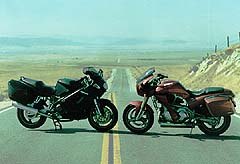



















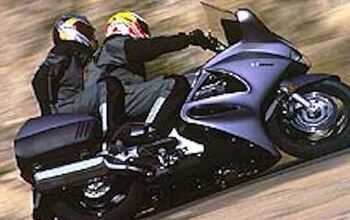
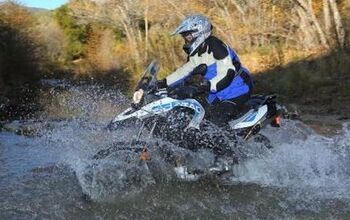
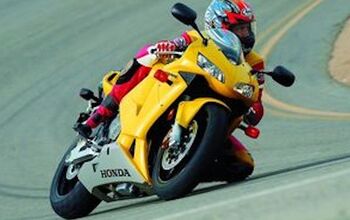
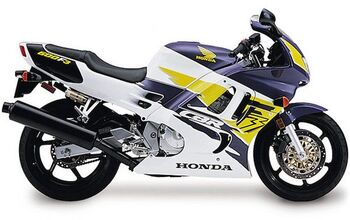

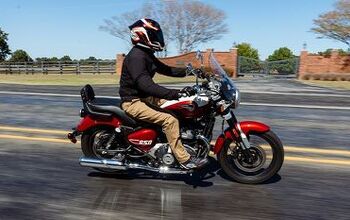



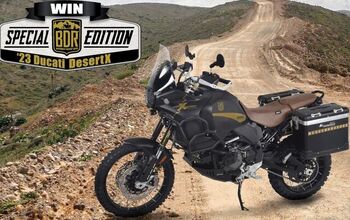







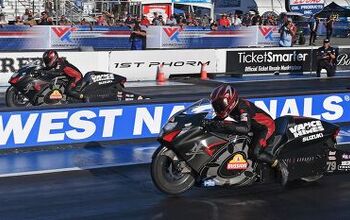
Comments
Join the conversation
I long for the days when bikes like the ST3 were more readily available; the only one left in this mold today is the R1200RS (now R1250RS). A modern ST based on the Monster 1200, for example, would be sweet.
Can't say I am particularly enthralled with the current beaked-out pseudo-adventure bikes.
It would be good to see 'touring sports' models today that are more like the ST2 and S3T. Today's ST equivalents are either adventure themed (and tall of seat), or bulky/heavy (I.e., more 'Sporty Tourer'). Or, like the Ninha H2 SX, crazily overpowered and pricey.